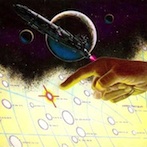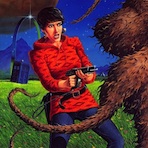Trivia
- The term "visiplate," which occurs in numerous stories by van Vogt including Slan, was first used in 1930 by E.E. "Doc" Smith in his novel Skylark Three when it was serialized in Amazing Stories. It was merely one of many terms used to describe the same type of device, with authors such as F.K. Kelly and Murray Leinster using it throughout the '30s and '40s, as well as in additional works by Smith. For more information, see http://www.jessesword.com/sf/view/446
- Slan was the first serial to to be given Astounding's "Nova" designation for outstanding work, and long remained a topic of discussion in the "Brass Tacks" section of the magazine where readers' letters were published. Throughout the 1940s Campbell would frequently make note of how hard it was to obtain the issues the serial appeared in, and that the Arkham edition was highly sought after, often selling for many times its cover price. The release of the 1951 Simon & Schuster edition was proudly trumpeted in a full-page ad in the January 1952 issue of Astounding.
- When planning the revision of the novel for Simon & Schuster in 1951, van Vogt marked up a copy of the 1946 Arkham edition. At some time this copy was part of Forrest J. Ackerman's collection, and is described by H.L. Drake in his non-fiction book A.E. van Vogt: Science Fantasy's Icon (pages 22-23). Especially in his early days as a writer van Vogt was a self-confessed poor typist, so he often used a printed version of the work as a working manuscript for his revisions. This tendency occasionally got the better of him, as he would sometimes cut up an old manuscript, inserting new pages and writing in the margins, thus destroying the original in the process.
- Many of van Vogt's heroes have an unfortunate propensity for taking control of their foes' minds, rather than achieving victory through other means. Although this approach is certainly novel and rarely seen used by heroes in literature — being a favorite technique of SF villains — it nonetheless doesn't sit too well with many readers (myself included). It's one of the least likable aspects of his fiction.
- Best-selling author Kevin J. Anderson was commissioned in January 2006 to write a sequel to Slan based on notes and an incomplete draft by van Vogt and his stepson Gregory Brayman. Although the draft was entitled Slan II: The Tendrilless War the final result is entitled Slan Hunter. It was serialized in the online magazine Jim Baen's Universe and was published in hard cover by Tor in July 2007.
Unresolved Questions
-
Why didn't the alarms at Air Central sound when Jommy entered to hijack the ship?
This was most probably due to some unknown property of his father's weapon, but this is never definitely established (112, 115).
-
Are slans really all that nice?
Although many passages emphasize how guileless and non-violent true slans are in their everyday lives (101, 140, 187), they are also shown to be masterful manipulators and cold-blooded killers on a vast scale (187- 8). The contrast between the idiotic pacifism of Peter Cross, and the ruthless machinations of Kier Gray — both "true" slans — couldn't be more striking, and is difficult to reconcile. Like people, perhaps they're more reasonable when they're not collected together in large, powerful groups.
-
Who was living in all those old slan refuges?
It's clearly stated that true slans are few in number by the time the main bulk of the story takes place, having been "replaced" by the tendrilless variety. The few true slans around are either part of the small but powerful organization secretly governing the human world, or "stragglers" who were scattered and fended for themselves since the slan government was overthrown over a thousand years previously. So who was living in the numerous and vast slan refuges scattered across the world, which are clearly newer than the tendrilless slan race?









